$\frac{1}{2}$
Coming Large Earthquakes in Japanese South-Sea Trough
Cat: SCI
Pub: 2025
#2501
Hiroki Kamata (鎌田浩毅)
250110u
Title
Coming Large Earthquakes in Japanese South-Sea Trough
次の南海トラフ大地震
Index
Key concept
Remarks
>Top 1. Common belief about the coming earthquake:
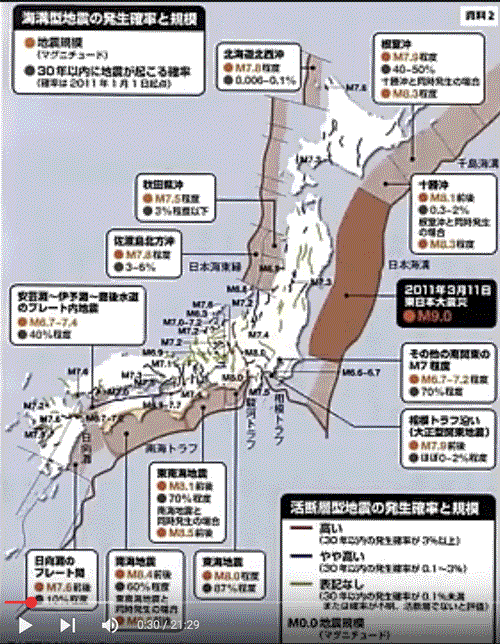
- Probable earthquakes and related eruption of volcano in the south-sea trough along the Pacific Ocean side of the Japanese archipelago.
- the next big earthquake (around M.9.0 or more) is sure to come; the only uncertain is when it will occur. It is actually calculated to occur in 2030's.
- There are two reasons:
- 1000 year cycle: after Jogan earthquake (869)
The era of the major crustal movement occurs in almost 1000 years; particularly after the Great East Japan Earthquake in 2011 (M9.0), Japanese archipelago became unstable; thus more large earthquakes occur.
- When oceanic plate (Pacific Ocean plate or Philippine Sea plate) subducts under the continental plate (N-American plate or Eurasian plate), there causes a seismic cause area between the boundary of two plates.
- Then, the the seismic cause area was broken and extended eastward (5.3m), and the sea level rose due to the earthquake.
- 100 year cycle: (South-sea trough earthquake)
- The Philippine plate subducts under the Eurasian plate.
- Large earthquakes have occurred as a series of linked mega earthquakes approximately every 100 years in the following three regions:
- A: South-sea earthquake region
- B: East-South-sea earthquake region
- C: East-sea earthquake region
- Historical mega earthquakes:
- 1606 Keicho Earthquake (M7.9): A+B+C
- 1707 Ansei Earthquake (M8.6): A+B+C
- 1854 Ansei Earthquake (M8.4): A+B+C
- 1944 Showa ES-sea earthquake (M7.9): B
+1946 Showa S-sea earthquake
: A
- The next mega earthquakes (to be named South-sea trough earthquake M9.1?) are sure to occur in about 2035±5: A+B+C
, which will release accumulated energy in the past 300 years, together with large earthquake and tsunami.
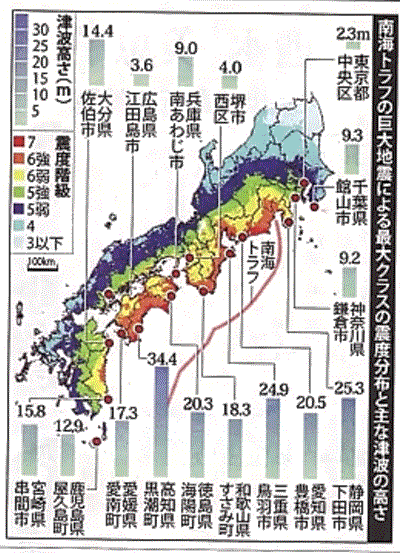
- Estimated damage from the coming Large South-sea Trough Earthquake (M9.1?; 'the Earthquake') will be:
- Maximum tsunami height: 34m (within 2-3 minutes in the earliest case)
- Areas attached with seismic intensity over M7.0: 151 cities, towns, and villages in 10 prefectures
- Causalities: 320,000
- Destructed housings & buildings: 2.38 million (60% of all wooden houses)
- Flooded areas by tsunami: 1000 sq.km
- Amount of total damage: 220 trillion yen (which is 10 times of the case of the Great East Japan Earthquake in 2011 (caused 20 T yen and 20,000 casualties)
- Calculation base of the estimated occurrence of the Earthquake:
- When an earthquake occurs, the ground level rises. Then it sing over time and returns to the original level.
- Thus the next earthquake can be predicted in years proportional to the amount of the uplift (m) between such a continuous earthquakes. [called the Time prediction model]
- When the ground rises, the seismic local port becomes unusable. These have been well recorded historically: particularly the uplift data of the Murotsu Port were well recorded by the government oficial.
- 1707: 1.8m rise
- 1854 (after 147 years): 1.2m rise
- 1946(after 92 years): 1.15m rise
- 2034-2039: extrapolating the above trends. Say, the Earthquake will come, say, in 2035-2040.
- The cycle of large Offshore earthquakes, Inland earthquakes, and Quiet periods:
- After the Showa earthquake (1944-46), there was a period of seismic quiet form 1960-1995.
- Actually the Great Hanshin-Awaji earthquake (M7.0) occurred in 1995 which ended 35 year-long seismic quiet period. Eventually this period coincided Japan's rapid economic growth period.
- Then inland earthquakes increased (such as Kumamoto earthquake (M7.3) in 2016, and Noto Peninsula earthquake (M7.0) in 2024.
- There is a trend of such cycle as 1) increase in inland earthquakes, 2) large offshore earthquakes, 3) decrease in inland earthquakes, 3) quiet period, 4) then increase in inland earthquakes.
- Therefore, an increase in inland earthquakes such as Kumamoto earthquake (2016) and Noto Peninsula earthquake (2024) will be a precursor to the next large offshore earthquakes.
- Japan has 111 active volcanoes, in which 20 volcanoes are expected to occur large volcanic earthquakes, such as:
- Maruyama, Hokkaido (Height 1692 m)
- Iwatesan, Iwate (H2038)
- Akita-Yakeyama, Iwate/Akita (H1366)
- Akita-Komagatake, Iwate/Akita (H1637)
- Nikko-Shiranesan, Tochigi/Gunma (H2578)
- Kusatsu-Shiranesan, Gunma/Nagano (H2160)
- Asamayama, Gunma/Nagano (H2568)
- Yakedake, Nagano/Gifu (H2455)
- Norikuradake, Nagano/Gifu (H3026)
- Hakusan, Ishikawa/Gifu/Fukui (H2702)
- Fujisan, Yamanashi/Shizuoka/Kanagawa (H3776)
- Hakoneyama, Kanagawa (H1438)
- Izu-Tobu Volcanos, Kanagawa (H-118)
- Izu-Oshima, Tokyo (H758)
- Niijima, Tokyo (H432)
- Kujusan, Ohita/Kumamoto (H1791)
- Asosan, Kumamoto (H1592)
- Tsurumidake & Garandake, Ohita (H1375)
- Nakanoshima, Kagoshima (H979)
- Suwanosejima, Kagoshima (H796)
- Mechanism of volcanic explosion:
- 5% water is contained in volcanic magma.
- Earthquake shaking creates cracks the crust and makes volcanic conduits.
- When the water vaporizes, its volume increases 500 times, causing the magma to rise and explode.
- In the case of Hoei eruption of Mt. Fuji in 1707, which induced the Hoei earthquake (M8.6) after 49 days.
- The next eruption of Mt. Fuji is likely to be triggered after 300 year of suspension. (around 1.5 scale of eruption of Hoei eruption)
- Eruption of a volcanic caldera (20km wide), which erupts 100-1000 times larger amounts larger than those of Mt. Fuji. The erupted ash blocks sunlight and causes a drop in temperature.
- In 1815/4 the caldera of Mt. Tambora, Sumbawa island in Indonesia erupted (M7.3). Which became the biggest eruption in the recorded history, and caused the worst volcanic disaster.
- The smoke reached the stratosphere and exceeded 40km in height. Darkness continued for 3 days even 500km away, and large tsunami happened. The number of causalities from this disaster is said more than 100-120,000.
- By this eruption, a big caldera (1100m deep) was made, and height of Mt Tambora changed from 4000 m to 2850 m, vanishing around 30 cu.km of the mountain volume. The total eruption was around 150 cu.km.
- The scale of this eruption is counted as 20 times of Vesuvio eruption (79), and 4 times of Kurakatau eruption (1883), and the energy was 52,000 times bigger than Hirosima-type N-bomb.
- The following year 'the summer was disappeared' in North America and Europe. And Hudson Bay in Canada froze even in midsummer. All corn was destroyed due to the frost in August, and continued abnormal low temperature for two years. (-4ºC lower than the average)
- In US farmers this promoted the westward migration. (one of the reasons for the Wild West era.)
1. 地震到来予測通説:
- 南海トラフ地震と関連した富士山噴火と首都直下地震の可能性
その理由は2つ:
- 理由はほぼ1000年ぶりに大地殻変動の時代
- 2011の東日本大震災以降
- 今後数10年は、地震と噴火の活動期
- ほぼ100年毎に南海トラフ巨大地震発生
- 阪神淡路地震(1995)以降、内陸地震が増加
- さらにこの地震に連動して、富士山噴火が誘発する。
- 300年前の1707年のにも誘発噴火が発生 (宝永噴火)
- またカルデラ噴火が起こると、地球温暖化から急に寒冷化
- 1000年毎の地震時計 (東日本大震災M9.0)
- 日本列島の太平洋側に海洋プレートが沈み込む
- 大陸プレートと海洋プレートの境界に震源域が発生
- 大陸プレートが沈降し、地震発生直後、震源域の固着域が
破壊され、東側に引き伸ばされる(5.3m)
(地震により海面隆起)
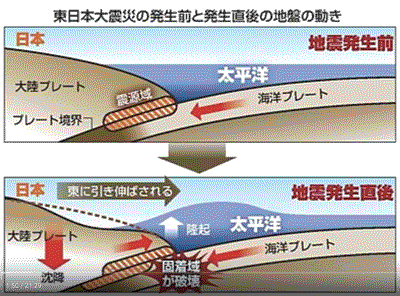
- 100年毎の地震時計(南海トラフ地震)
貞観地震 (869)以降
- フィリピンプレートがユーラシアプレートに沈み込む
- 3震源域(A南海地震域; B東南海地震域; C東海地震域)
- ほぼ100年毎に3震源域が一連の連動地震として発生
- 1605 慶長地震(M7.9): A+B+C
- 1707 宝永地震(M8.6): A+B+C
(1703 赤穂事件の翌年の
元禄地震で元禄から宝永へ改善)
- 1854 安政地震(M8.4): A+B+C
- 1944 昭和東南海地震 (M7.9)
+1946 昭和南海地震(M8.0): A+B
- 2035±5 南海トラフ巨大地震 (M9.1?): A+B+C
- 300年に1回は同時期に発生: 地震と津波大規模
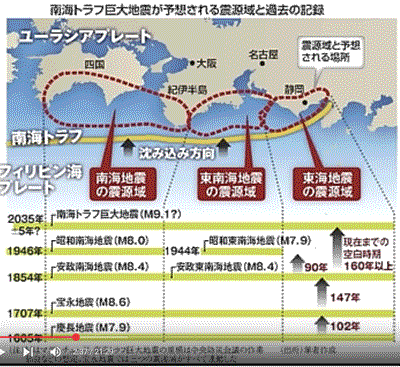
- 南海トラフ地震(M9.1)の被害予想:
- 最大津波高: 34m (2-3分後)
- 震度7の地域: 10県 151市町村
- 犠牲者: 32万人
- 全壊建物: 238万棟 (木造家屋の60%)
- 浸水面積: 1000 k㎡
- 被害総額: 220兆円 (東日本大震災20兆円&2万人の10倍
- 2035±5年の根拠
- 室津港の隆起データ (当時の役人が記録)
- 地震時の隆起量(m)に比例した年数で地震発生
[時間予測モデル: 隆起後、時間をかけて沈降]
- 1707年 1.8m
- 1854年(+147) 1.2m
- 1946年 (+92) 1.15m
- 2035±5年: [時間予測モデル]
上記の傾向を外挿すると次期地震発生は2034-2039

- 海の巨大地震、内陸地震、静穏期のサイクル:
- 1944-46の昭和地震の後、1960-1995年は地震の静穏期。
1995年に阪神淡路大震災発生
- 1960-95の地震の静穏期と日本の高度成長の時期と一致
- 内陸地震の増加 →海の巨大地震 →内陸地震の減少
→地震の静穏期 →内陸地震の増加 (熊本地震、能登半島地震)
を繰り返す傾向
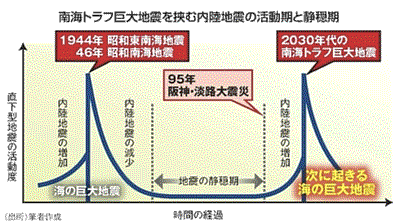
- 日本の活火山 (日本には111活火山、内20で火山性地震)
- 北海道: 丸山
- 東北: 秋田焼岳、秋田駒ケ岳、岩手山
- 群馬: 日光白根山、草津白根山
- 長野: 浅間山、乗鞍岳
- 岐阜: 白山、焼岳
- 山梨: 富士山
- 静岡: 箱根山、伊豆大島、伊豆東部火山群
- 東京: 伊豆大島、新島
- 大分: 鶴見岳・伽藍岳、九重山
- 熊本: 阿蘇山
- 鹿児島: 中之島、諏訪之瀬島
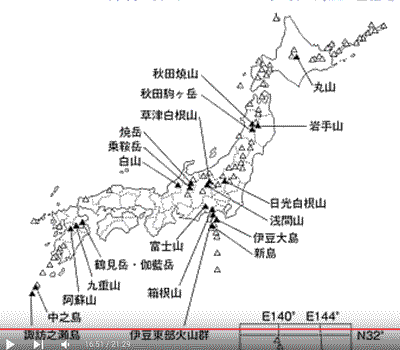
- 火山爆発
- 火山のマグマ中に5%水分。地震の揺れで火道に割れ目
- 水蒸気化すると体積500倍となりマグマが上昇し爆発
- 1707年富士山の宝永噴火:
- 宝永地震の49日後に噴火誘発
- 次回の富士山噴火も300年の休止後の噴火誘発の可能性大
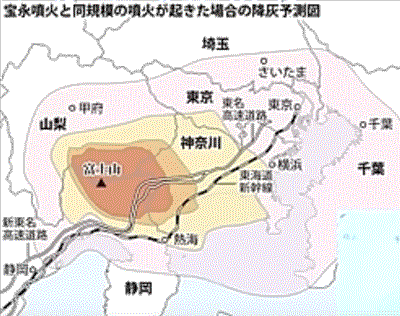
- カルデラ火山の噴火 (幅20km)は 富士山噴火より100-1000倍大きい
- 噴出する火山灰が太陽光を遮り、気温低下をもたらす
- 1815年インドネシア・タンボラ火山のカルデラ噴火
- 高度30,000mまで火山灰 (偏西風で世界を巡る)
- 翌年から北米と欧州で"夏がなくなった"
- 真夏にカナダ・ハドソン湾が凍った
- 8月に霜: トウモロコシ全滅
- 2年後まで異常低温:
米国では農民の西部移住(西部開拓の一因)
- 平均気温: 例年の-4ºC
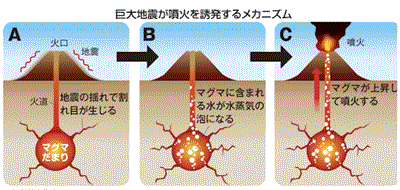
Re:
- Plate Tetnics around Japan (by Wikipedia 2024) >Fig.
- $\log_{10}E=4.8+1.5M$
- herein $10^{1.5}≒31.62$
- M becomes 32 times of energy (E) by increase of 1.0 of M
- M becomes 100 times of energy (E) by increase of 2.0 of M
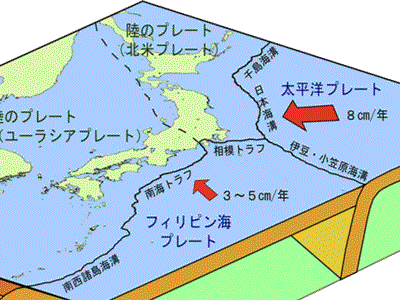
>Top 2. Hoei Eruption of Mt. Fuji (1707):
- 1707: Hoei eruption of Mt. Fuji (1707):
on Oct. 28, 1707, Hoei Tokai-Nankai Earthquake (M8.7) occurred, causing the damage to more than 5,000 people. The old record says that:
- Since 10:00 on Dec.16, 1707, an explosive eruption started near the 5th level on the southeastern slope of Mt. Fuji; during which time pumice and volcanic bombs continued to release for about 16 days until the early hours on Jan. 1, 1708. The eruption continued intermittently.
- The plume rose to a height of 15-20 km and fell over a wide are of Kanto region carried by westward wind.
- In the vicinity of Mt. Fuji, hot and heavy ejecta burned ;and collapsed many houses. In addition, rainfall caused volcanic ash to flow out as river floods.
- Mt. Fuji has been quite active volcano, whose erupted deposits have been confirmed about 180 times in the last 1500 years, but it has not erupted since the Hoe eruption in 1707. During Jogan eruption in 864-866 a large amount of lava formed Aokighara Lava Plateau.
- Volcanic ash and lapilli from the Hoei eruption deposited thickly to the east of Mt. Fuji, which reached Edo in about 1-2 hours. The thickness of fallen ash was 300 cm in Oyama, Shizuoka prefecture 10 km away,where hot pumice burned down many housed, 30 cm in Isehama city, Kanagawa prefecture 50km away, where made farming impossible, 8 cm in Ichihara city, Chiba prefecture 120km away and about 5 cm even in Edo.
- Volcanic ash is 3-5 times heavier than snow, so there is a risk of collapsing of houses. At greater distances, the ash turns into fine particles, which in itself is not life threatning, but it contains sharp particles such as glass which may damage cornea and make breathing difficult.
- Even nowadays a small amount of ash fall can be a major impact on lifelines. It can adhere to railways, runways, roads, engines, and insulators reducing insulation and causing power outages.
- Furthermore, deterioration of drinking water due to volcanic ash contamination and soil runoff by rainfalls will have long-term or several decade effects, prolonging the damage.
- In the early stage of the eruption, white dasite-type pumice was ejected, thereafter followed by black basaltic pumice scoria. The amount of volcanic ash released accounted more than 1.8 sq.km.
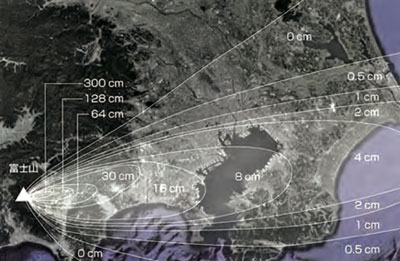
- 1703: Genroku earthquake occurred before the Hoei eruption in 1707. On Dec 31, 1703 (Genroku 16th, the year after the Ako incident), Genroku earthquake (M8.2) occurred near Sagami Bay, killing approximately 6,700 people. Rumblings were recorded at Mt. Fuji 35 days after the earthquake on Feb 4-7, 1704.
2. 富士山の宝永噴火 (1707): (富士山科学研究所資料)
- 1707: 富士山の宝永噴火 (1707):
- 1707/10/28 宝永東海南海地震(M8.7)発生し、5000人以上が被害。
- 1707/12/16/10:00 (宝永7) に富士山南東中腹5合目付近から爆発的に噴火を起こし、その間軽石や火山弾の放出が続き、その後約16日間1708/1/1未明まで断続的に続いた。
- 噴煙の高さは15-20kmに立ち上がり、偏西風に乗って関東の広範囲に降り注いだ。
- この噴火で、南東中腹には3つ以上の加工が開き、宝永山が形成された。
- この噴出物により富士山周辺では、家屋は倒壊し、農作物は工作不能となった。また降雨による火山灰の流出で河川の氾濫を引き起こした。
- 富士山は1707年の宝永噴火以降、噴火を起こしていない。しかし、最近5600年間に約180回の噴火堆積物が確認されており、高頻度で噴火してきた。864-866の貞観噴火の際には、大量の溶岩が青木ヶ原溶岩台地を形成した。
- 宝永噴火による火山灰や火山礫は、富士山東方に厚く堆積した (1-2時間で江戸に到達)。10km離れた静岡県小山町で300cm (高温の軽石で家屋も焼失)で、 50km離れた神奈川県伊勢原市で30cm (耕作不能)、120km離れた千葉県市原市で8cm、江戸でも5cm 程度の降灰があった。
- 火山灰は雪より3-5倍重たいので、建物倒壊の危険性がある。遠方では細粒の火山灰となり、それ自体に生命の危険はないが、ガラス片など鋭利な粒子もあり角膜の損傷や呼吸が息苦しくなる可能性がある。
- 少量の降灰でもライフラインへの影響は大きい。鉄道・滑走路・道路・エンジン・碍子への付着による絶縁低下から停電などが発生する。
- また火山灰の混入による飲料水の悪化、降雨時の土砂の流出は長期間(数〜数十年)影響し、被害が長期化する。
- 噴出物は、噴火初期には白色のDasite質の軽石が噴出し、その後は黒色の玄武岩質の気泡のある軽石scoriaである。放出された火山灰量は、約1.8km3以上とされている。
- 1703: 元禄地震: 宝永噴火の前の地震:
- 1703/12/31 (元禄16; 赤穂事件の翌年)に、相模湾周辺を震源とする元禄地震(M8.2)が発生し、約6700人が犠牲となった。
- この地震の35日後の1704/2/4-7に富士山での鳴動が記録されている。
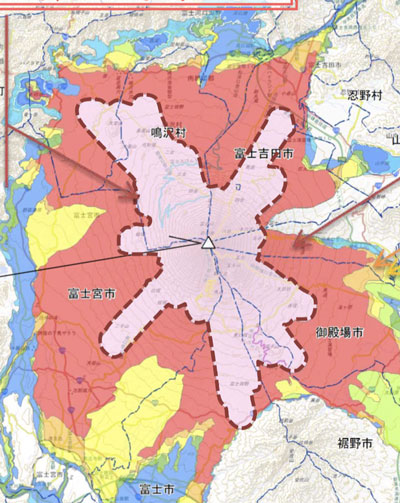
>Top 3.
3.
Comment
- Historical records of paper and ink by ancient people in Japan have great use in understanding natural or earthquake predictions.
- Natural phenomena occur extending far beyond the lifespan of an individual, spanning several centuries or much more. Such ancient records are quite valuable when dealing with such long-term as natural phenomena.
- In comparison, modern people tend to neglect the value of preservation, or in some cases even to falsify the official documents.
- Digital documents tend to be easily erased and lost, which seem quite unsustainable. We should reconsider the value of permanent records, trying to leave the actual records on microfilm for future generation.
- 日本の自然現象に関する古人による紙と筆による記録は、極めて詳しく現代の地震予測に大いに役立っている。
- 自然現象は、個人の寿命を超えて数世紀やそれ以上に亘る現象であり、その長期間の現象を扱うには、長期的で地道な記録が価値を持ってくる。
- それに比べ現代人は、記録や文書保存を軽視しており、中には改竄まで行う始末である。
- デジタル文書は、簡単に消去されやすいし、記録方法も継続性がない。後世の人に対して恥ずかしくないように今からでもマイクロフィルムなど精緻な記録を永続的に残すことを考えるべきだと思う。
$\frac{1}{2}$ |
Coming Large Earthquakes in Japanese South-Sea Trough |
Cat: SCI |
Hiroki Kamata (鎌田浩毅) |
250110u |
Title |
Coming Large Earthquakes in Japanese South-Sea Trough |
次の南海トラフ大地震 |
|---|---|---|
Index |
Key concept |
Remarks |
>Top 1. Common belief about the coming earthquake:
|
1. 地震到来予測通説:
|
Re:
|
>Top 2. Hoei Eruption of Mt. Fuji (1707):
|
2. 富士山の宝永噴火 (1707): (富士山科学研究所資料)
|
>Top 3. |
3. |
Comment |
|
|